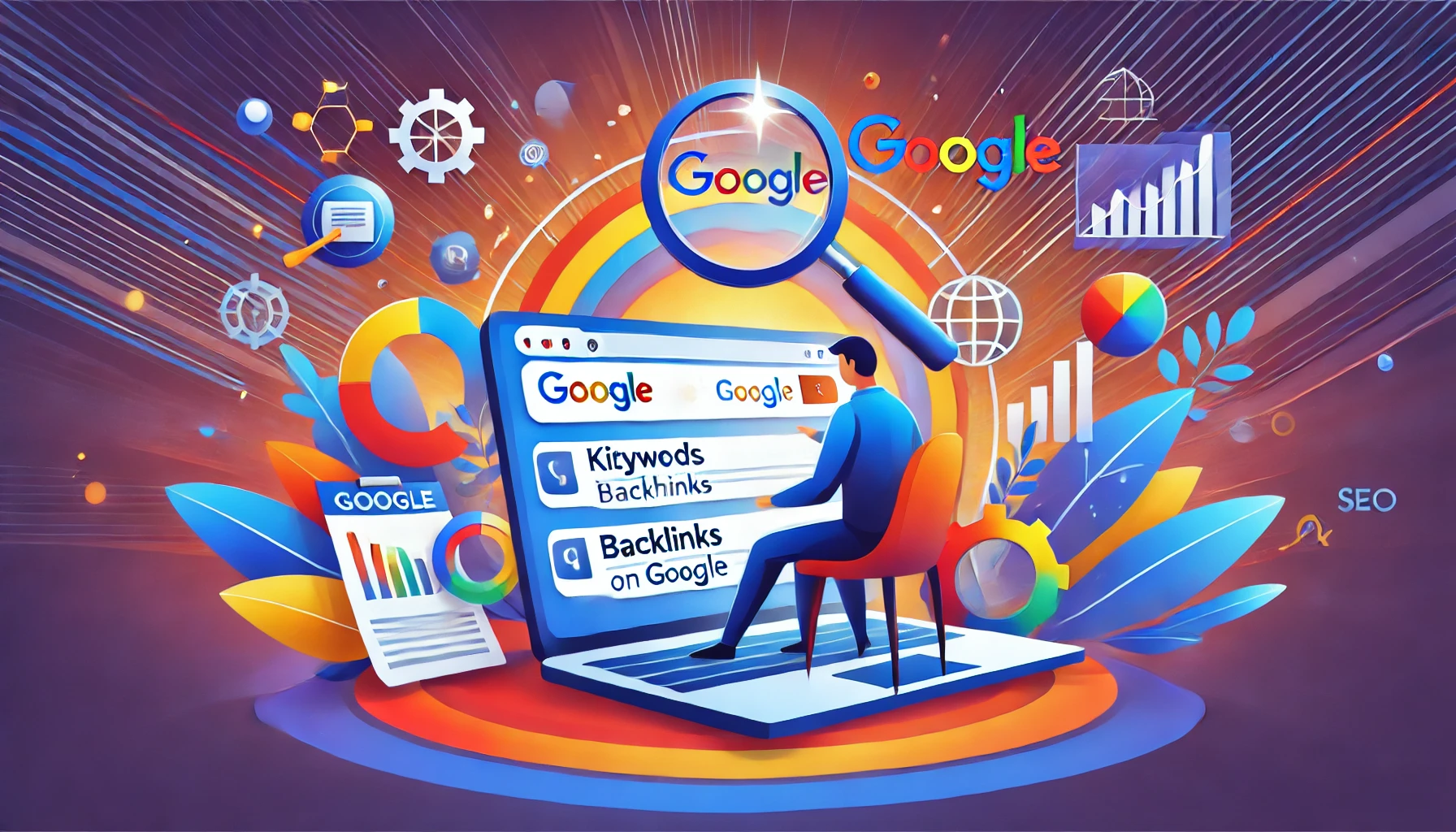
Want to see your website climb to the top of Google search results? SEO (Search Engine Optimization) is the secret to unlocking more traffic, visibility, and conversions. In this comprehensive guide, we will discuss the top 5 SEO hacks that can significantly boost your website’s ranking on Google. From optimizing your content to building credible backlinks, these strategies are designed to improve your search engine rankings effectively. This guide will also include charts, diagrams, tables, and highly searched questions to make it even more informative and engaging. Whether you are a beginner or an experienced marketer, these tips will help you enhance your SEO game and achieve better results.
1. Optimize Your Content for User Intent
One of the most crucial SEO hacks is to align your content with user intent. Google prioritizes content that matches what users are looking for, so it’s essential to understand what your audience needs and craft content that directly answers their questions. User intent can be categorized into various types, and understanding these can help you create more targeted and effective content.
Types of User Intent
| User Intent | Description |
|---|---|
| Informational | User wants to learn more about a topic |
| Navigational | User wants to find a specific website |
| Transactional | User is looking to make a purchase |
| Commercial Investigation | User is researching before making a decision |
Pro Tip: Use tools like Google Keyword Planner, Ahrefs, or AnswerThePublic to find out what your audience is searching for. Create high-quality, informative content that addresses those queries directly. Additionally, focus on structuring your content with headings, bullet points, and visuals to make it easier for users to find the information they need. Consider including FAQs, comparison tables, and case studies to further enhance the value of your content.

The diagram above illustrates how different types of user intent influence content creation. Aligning content with these intents ensures higher relevance and better rankings.
Need help creating SEO-optimized content? Contact us here for expert guidance.
Examples of Optimizing Content for User Intent
- Informational Intent: If users are searching for “how to improve page speed,” create a detailed guide covering page speed optimization techniques. Include actionable steps and visual aids to help users follow along easily.
- Transactional Intent: For users searching for “buy SEO tools,” create product pages that include clear descriptions, pricing, customer reviews, and easy call-to-action buttons to drive conversions.
- Commercial Investigation: If users are comparing products, provide a comparison chart or an in-depth review that helps them make an informed decision.
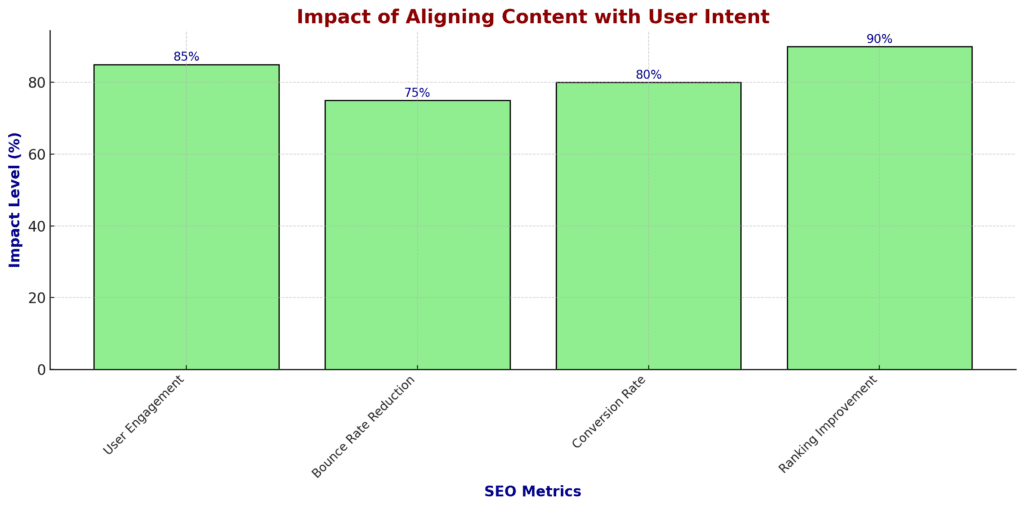
The chart illustrates how aligning content with user intent can improve user engagement, reduce bounce rates, and increase conversion rates.
2. Use Long-Tail Keywords
Long-tail keywords are more specific phrases that have lower search volume but often higher conversion rates. By targeting long-tail keywords, you can reach a more precise audience and improve your chances of ranking higher for specific queries. Long-tail keywords are particularly useful for small businesses that are trying to compete with larger players in the industry.
Benefits of Using Long-Tail Keywords
| Benefit | Description |
| Less Competition | Easier to rank due to less competition |
| Higher Conversion Rate | Targeted audience with high intent to purchase |
| Better Audience Targeting | Focused on specific needs of users |
| Improved Content Relevance | Aligns more closely with user searches |
Pro Tip: Use tools like Ubersuggest, SEMrush, or Moz Keyword Explorer to discover long-tail keywords that fit your niche. Incorporate these keywords naturally into your content for better ranking. Make sure to place them strategically in headings, meta descriptions, and throughout your content to maximize their impact. You can also use these keywords in image alt texts, URLs, and internal links to further optimize your page.
Long-Tail Keyword Chart
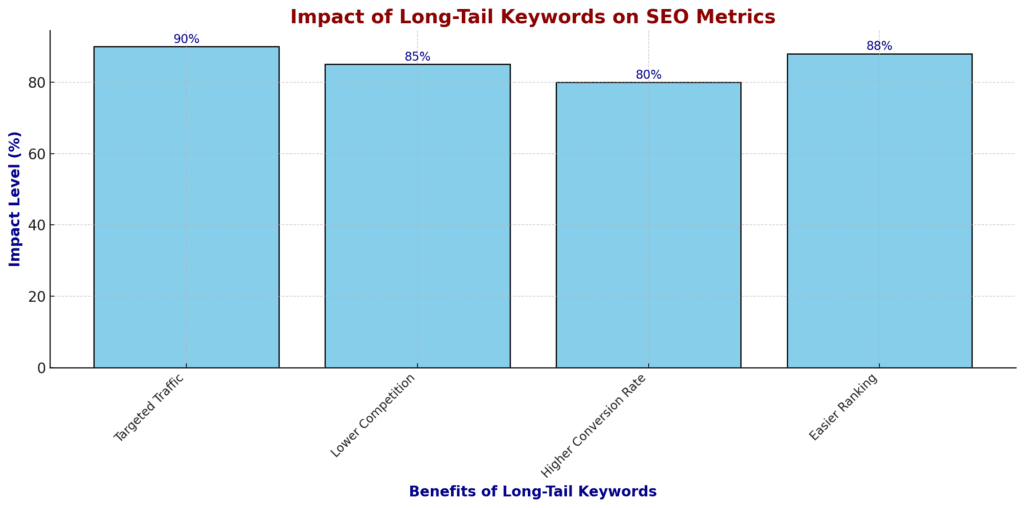
This chart shows how long-tail keywords help in driving more targeted traffic. Long-tail keywords often have lower competition, making it easier to rank for them.
Example: Instead of targeting a broad keyword like “SEO tips,” use a long-tail keyword such as “SEO tips for small businesses in 2024” to attract a more specific audience looking for exactly that information. This approach not only improves your chances of ranking but also helps you connect with users who are more likely to convert.
Long-Tail Keyword Placement Diagram
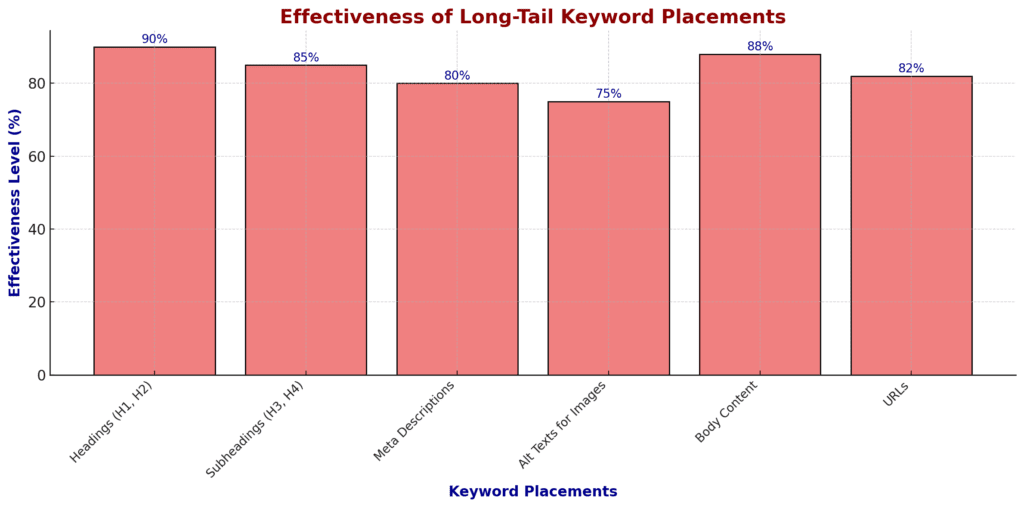
The diagram illustrates ideal placements for long-tail keywords, including headings, subheadings, meta descriptions, and alt texts.
Boost Your Business Today!!
Ready to Take Your Digital Marketing to the Next Level?
Let’s connect and make it happen!

3. Improve Page Load Speed
Google considers page load speed as an important ranking factor. A slow-loading website can lead to higher bounce rates, which negatively impacts your SEO. Optimizing your website’s load speed can help enhance user experience and increase rankings. Fast-loading websites also tend to have better user engagement metrics, which are key factors in Google’s ranking algorithm.
Tips to Improve Page Speed
- Compress Images: Use tools like TinyPNG or ImageOptim to compress images without compromising quality. Large images can significantly slow down your website.
- Enable Browser Caching: Save static resources in the user’s cache so the website loads faster upon subsequent visits. This helps improve repeat visits and reduces server load.
- Minimize HTTP Requests: Reduce the number of elements like scripts, images, and CSS files to improve loading time. Combining CSS and JavaScript files can help minimize requests.
- Use a Content Delivery Network (CDN): CDNs distribute your website’s content across multiple servers worldwide, ensuring faster access for users regardless of their location.
- Minify CSS, HTML, and JavaScript: Reduce the size of your code files by removing unnecessary spaces and comments. Tools like Minify can help with this.
- Implement Lazy Loading: Load images and videos only when they are visible on the screen to save bandwidth and improve page speed.
| Speed Optimization Technique | Effectiveness (Scale of 1-10) |
| Image Compression | 9 |
| Browser Caching | 8 |
| Minimize HTTP Requests | 7 |
| Content Delivery Network | 9 |
| Minify CSS/HTML/JavaScript | 8 |
| Lazy Loading | 7 |
Pro Tip: Run your website through Google PageSpeed Insights or GTmetrix to identify what’s slowing down your page. Fix these issues to improve your ranking and overall user experience. Regularly monitor your website’s speed metrics to ensure optimal performance.
External Link: Learn more about Google’s page speed guidelines at Google Developers.
Page Speed and SEO Chart
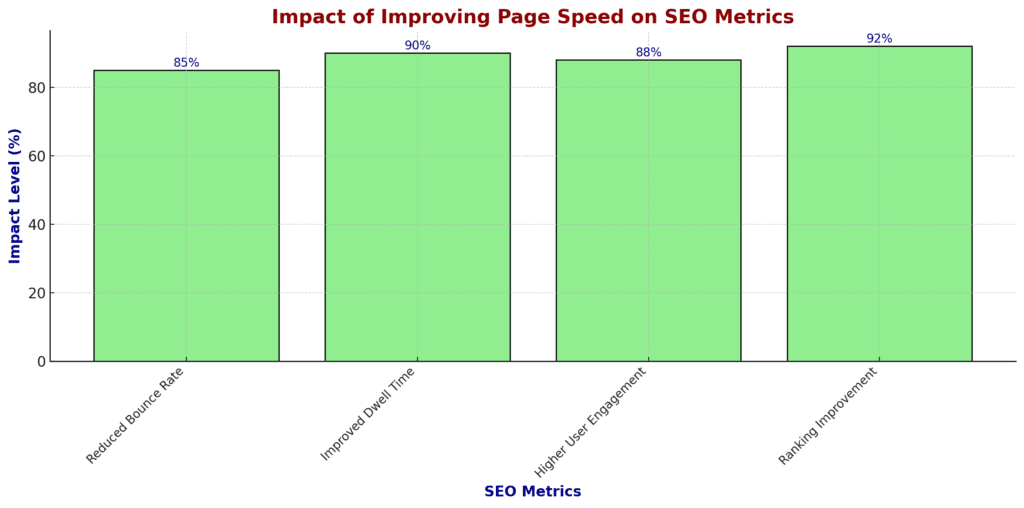

This chart illustrates how improving page speed can positively impact your SEO metrics, including reduced bounce rate and improved dwell time.
Page Speed Optimization Checklist
- Compress and Optimize Images
- Use Asynchronous Loading for JavaScript
- Leverage Browser Caching
- Minify Resources
4. Create High-Quality Backlinks
Backlinks are a major factor in Google’s ranking algorithm. Getting links from authoritative websites helps signal to Google that your content is trustworthy and valuable. Focus on creating content that people want to link to, such as research reports, infographics, or in-depth guides. Backlinks from credible sources are considered “votes of confidence” for your site.
Types of Backlinks to Focus On
| Type of Backlink | Description |
| Editorial Links | Natural links from reputable websites |
| Guest Blog Links | Links obtained by writing guest blogs |
| Resource Page Links | Links from resource or curated content pages |
| Niche Directory Links | Links from industry-specific directories |
| Broken Link Building | Replacing broken links with your own valuable content |
Pro Tip: Reach out to relevant websites and offer to write guest posts or collaborate. Make sure the backlinks are from high domain authority (DA) websites for the best SEO impact. Additionally, consider using broken link building techniques to identify and replace broken links with your content. Tools like Ahrefs can help you find these opportunities.
Backlink Quality vs. Quantity
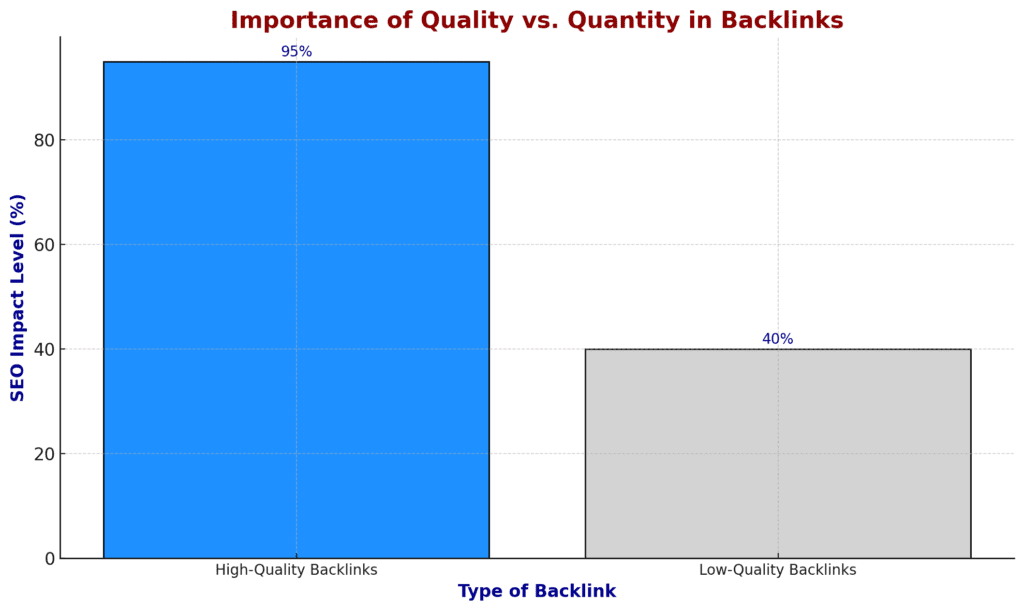

This Chart illustrates the importance of quality over quantity when it comes to backlinks. A few high-quality backlinks from authoritative websites can be more impactful than numerous low-quality links.
To get professional help in building high-quality backlinks, contact us.
How to Create High-Quality Backlinks
- Guest Blogging: Write valuable content for high-authority blogs in your niche. Provide unique insights and actionable advice to encourage links.
- Skyscraper Technique: Find popular content, improve it, and reach out to those linking to the original content. Add extra value by including updated information, new insights, or multimedia elements like videos and infographics.
- Infographics: Create visually appealing infographics that others can link to as a resource. Infographics are highly shareable and can earn you quality backlinks from authoritative websites.
- Broken Link Building: Identify broken links on relevant websites and offer your content as a replacement. This technique helps webmasters fix issues on their sites while providing you with a valuable backlink.
5. Optimize for Mobile Users
More than half of all Google searches come from mobile devices. Therefore, optimizing your website for mobile users is crucial to ranking well on Google. A mobile-friendly website ensures that your content is easily accessible, regardless of the device users are using. This involves optimizing your website layout, navigation, and content so that everything displays and functions properly on smaller screens. Google also gives preference to mobile-friendly sites when ranking search results, especially for users browsing on mobile devices.
Tips for Mobile Optimization
- Responsive Design: Use a responsive web design that automatically adjusts the layout to fit different screen sizes. This ensures that your content remains easily readable and visually appealing on all devices.
- Readable Text and Images: Make sure the text size is appropriate for mobile screens. Users shouldn’t have to zoom in to read content. Images should also be responsive and load quickly.
- Touch-Friendly Elements: Buttons, links, and form fields should be easy to click on a touch screen without accidentally clicking other elements. Proper spacing helps ensure a smooth user experience.
- Mobile Site Speed: Speed is crucial for mobile optimization. Slow-loading pages can lead to high bounce rates, which negatively impacts your SEO.
- Simplified Navigation: Keep navigation menus short and simple. Ensure that users can easily find important pages with minimal clicks.
- Avoid Pop-Ups: Pop-ups can be difficult to close on mobile devices and can disrupt the user experience. Consider disabling them for mobile users.
| Mobile Optimization Factor | Importance (Scale of 1-10) |
| Responsive Design | 10 |
| Readable Text and Images | 9 |
| Touch-Friendly Elements | 8 |
| Mobile Site Speed | 9 |
| Simplified Navigation | 8 |
| Pop-Up Avoidance | 7 |
Pro Tip: Use Google’s Mobile-Friendly Test tool to analyze how well your site performs on mobile devices and fix any issues found. Mobile optimization is not just about making your site look good—it’s about providing a seamless and fast user experience.
Example: If you have an e-commerce website, make sure that the checkout process is mobile-friendly. Include large buttons, simple forms, and a secure payment process to improve the user experience for mobile shoppers.
Impact of Mobile Optimization on SEO
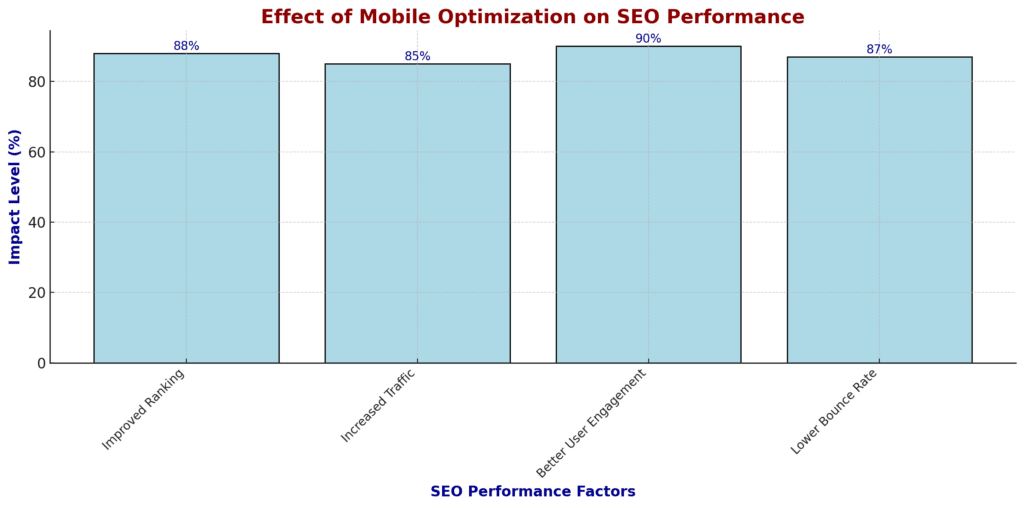

The chart above shows the effect of mobile optimization on overall SEO performance. Optimizing for mobile users can lead to improved ranking, increased traffic, and better user engagement.
To understand Google’s best practices for mobile optimization, check out Google’s Mobile SEO Guide.
Highly Searched Questions About SEO Hacks
1. What is the fastest way to improve Google rankings?
The fastest way to improve Google rankings is by focusing on content quality, optimizing page speed, and building high-quality backlinks. Making sure that your content matches user intent and is optimized for mobile users can also make a significant difference. Regularly updating your content and adding value with unique insights can also help in boosting rankings faster.
2. How can I find the best keywords for SEO?
You can use keyword research tools like Google Keyword Planner, Ahrefs, or SEMrush to find keywords that have good search volume and lower competition. It’s important to focus on long-tail keywords that align with your target audience’s intent. Additionally, consider analyzing your competitors’ keywords to identify gaps and opportunities for your own content.
3. How many backlinks do I need to rank on the first page of Google?
There is no set number of backlinks required to rank on the first page of Google. The quality of backlinks is more important than quantity. A few high-quality backlinks from authoritative sites are more valuable than hundreds of low-quality links. Focus on building relationships with credible sites and creating content that naturally attracts links.
4. How does page speed affect SEO rankings?
Page speed is a crucial factor in SEO rankings because it directly affects user experience. Slow-loading pages result in higher bounce rates, which signals to Google that users are not finding the content engaging. By improving your page speed through image compression, browser caching, and minimizing HTTP requests, you can provide a better user experience and boost your rankings.
5. What makes content SEO-friendly?
SEO-friendly content is well-structured, uses relevant keywords, matches user intent, and provides valuable information. It should include headings, bullet points, and internal links to make navigation easier for users and search engines. Adding visual elements like images, videos, and infographics can also enhance the content’s engagement, making it more likely to rank well.
For more personalized help with SEO and digital marketing, feel free to contact us here. Our experts are ready to help you boost your Google ranking.
For related articles, tips, and insights into improving your website’s performance, visit our Nova Vision
Final Thoughts
Ranking on Google is achievable with the right strategies. By optimizing content for user intent, using long-tail keywords, improving page speed, creating high-quality backlinks, and optimizing for mobile users, you can boost your website’s visibility on Google. Implement these SEO hacks, and watch your website climb the rankings.
Feel free to contact us for personalized advice or to learn more about our SEO services. We’re here to help you take your website to the next level.
FAQs Section
- What is the best way to rank a new website on Google?
Focus on creating high-quality, keyword-optimized content, improve your page speed, and build backlinks from reputable sites to rank a new website on Google. - How important are keywords in SEO?
Keywords are crucial for SEO as they help Google understand the content of your page and match it to user search queries. Effective keyword research and placement can greatly improve your search rankings. - How often should I update my website for SEO?
It’s best to update your website regularly. Adding fresh content, updating old posts, and ensuring your website meets the latest SEO best practices can help maintain or improve your ranking.
Boost Your Business Today!!
Ready to Take Your Digital Marketing to the Next Level?
Let’s connect and make it happen!





